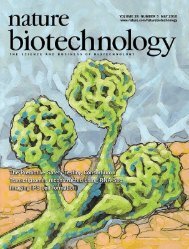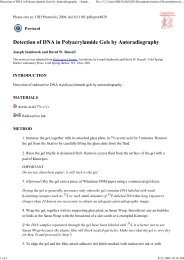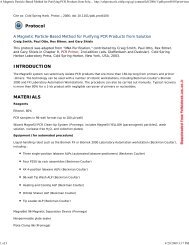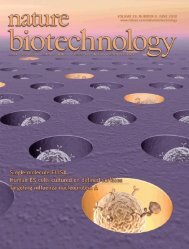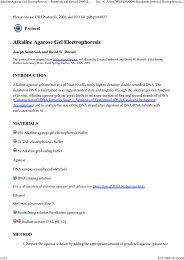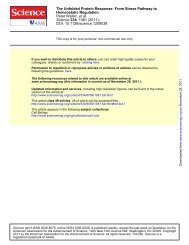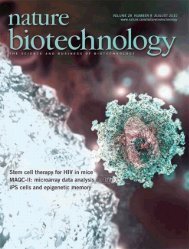Ontology engineering
Ontology engineering
Ontology engineering
Create successful ePaper yourself
Turn your PDF publications into a flip-book with our unique Google optimized e-Paper software.
NEWS© 2010 Nature America, Inc. All rights reserved.“This was a unique opportunity to takeadvantage of their plant cell technologyplatform with this lead drug to perhaps providea more cost-effective therapy,” he says,adding that treatments for lysosomal storagediseases have typically been among the mostexpensive, costing several hundreds of thousandsof dollars annually. Protalix’s phase 2data and interim reads on its phase 3 study,including available reports from data safetyand monitoring boards, were reassuring, aswas the fact that regulators had asked Protalixto initiate early access programs. “Typically,companies are not asked to do that unlessFDA or EMEA [the European MedicinesAgency] or both have a good level of comfortaround the safety and efficacy of the drug,”says Curtis. “All those things came to bear onthe comfort level we had with Protalix, eventhough it would be the first plant cell–basedtherapy to be approved.”Curtis is also quick to point out thatalthough there may be future opportunitiesto leverage the Protalix platform, this was aproduct-oriented transaction. “This deal wasborn from the commercial arm of Pfizer. Wesee this obviously as an opportunity to workmore closely with them going forward, tomaximize their technology platform, but thetechnology platform trailed behind. We gotthe drug and along the way discovered howwonderful the platform is.”Beyond prGCD, the Protalix technologyplatform could potentially provide opportunitiesfor Pfizer to work in other raregenetic diseases and even beyond that, inthe production of biosimilars, to lower thecost of goods, says Curtis. Protalix also hasprograms in preclinical development for abiosimilar version of the anti-tumor necrosisfactor alpha fusion receptor protein Enbrel(etanercept) and for enzyme replacement totreat Fabry’s disease, another lysosomal storagedisorder.In plant biotech, as is true for other biotechdeals, the trend “seems to have gone,over the last ten years, away from companiesthat have platform technology much moretowards product-driven investments,” saysCharles Arntzen of the Biodesign Institute atArizona State University in Tempe. “Protalixnever goes around talking that they have acell-culture system, except at plant meetings.They focus on the enzyme they are producingand the product niche it will fit into.”Pittsboro, North Carolina–based BiolexTherapeutics is the only other company witha plant-derived compound in late-stage trials.Their controlled-release form of interferonα-2b made in aquaculture, currentlyBox 1 Green antibody farmingViral vectors have enough going for them that the technique could become a staple forprotein production in whole plants; they can achieve high levels of expression in a veryshort time. “You can use agrobacterium, for example, to essentially bathe the interiorsurface of the leaf,” says Arntzen. “Once you get one copy of the merged virus [it is usuallyintroduced in two parts along with a recombinase delivered as a separate gene] in the cell,boom, off it goes. You adjust conditions so you have a coordinated assembly so every cellin the leaf is simultaneously getting the effect of having a virus starting its replication inthat cell.” Icon was among the first to successfully use these viral vectors, and there are atleast a dozen other companies that have gone that way. “It looks to me like the wave of thefuture,” Arntzen says.The biggest advantage may come in producing monoclonal antibodies, where the bestwork is being done using two separate viruses: one produces the light chain, the other theheavy chain. Essentially, two RNA species are introduced into a single cell at the sametime. “They assemble beautifully and it’s routine now to get about half a gram of antibodyout of a kilogram of plant leaves,” says Arntzen.“There are enough data, not necessarily all published, especially for immunoglobulinsof IgG type made in plants, and enough information and knowledge in several largecompanies to say that all these antibodies are fully active and pharmacologically asgood as those produced in other systems,” says Gleba, adding that Genentech of S.San Francisco, California, and others have shown that their existing molecules are lesseffective because of fucose added to the glycans. “If you remove it, the effector functionimproves dozens of times and that should directly translate into therapeutic effect, so youneed less of the molecule,” he says.MRin phase 2b for the treatment of hepatitis C,received $60 million in venture funding froma group led by Clarus Ventures and OrbimedAdvisors, both known for late-stage, product-orientedinvestments.It’s long been believed that plant cell–based manufacturing has the potential to beless expensive than mammalian or Chinesehamster ovary cell–based methods, in partbecause plants produce protein with a glycosylationpattern closer to human, saysArntzen (Box 1).That’s apparently the case with prGCD. Toproduce Ceredase and Cerezyme, Genzymehas to clip off additional sugars to exposeterminal mannose residues, says DavidAviezer, Protalix’s president and CEO.“With plant technology, by performing ER[endoplasmic reticulum] retention of theprotein during the glycosylation process, wecan obtain the correct mannose glycosylationpattern directly made by the cell.” Thatreduces processing costs—prGCD could bean order of magnitude less expensive to producethan either Cerezyme or another potentialcompetitor such as Shire’s velaglucerase.Chineham, UK–based Shire is expecting anFDA approval decision for their product bythe end of February 2010.Yet some in the field see Protalix’s platformas a somewhat crude first-generationtechnology that only touches on the potentialfor plant-based pharmaceutical produc-tion. “You increase the cost of production bygoing back to fermenters,” says Yuri Glebaof Icon Genetics, now part of the BayerInnovation Group in Halle, Germany. What’smore, expression is not exceptionally highin the Protalix cell line, and the company isusing expression cassettes that have been incirculation for a generation, he says. “Protalixhas shown these fermenters are cheaper, soyou can have 20–30% cheaper product as aresult, which could justify the new businesscase. But with other technologies you can geteven higher expression levels and lower costof goods,” he adds.On the other hand, cell culture brings theadvantages of a plant organism in “the sameregulatory environment FDA has learned andset for the last 20 years” for biopharmaceuticals,says Aviezer—in clean rooms and underthe same standard operating procedures forgrowing mammalian cells and purifying proteins.And Icon’s Gleba acknowledges thatProtalix’s success in product developmentwith prGCD shows they have a keen businesssense. “If you are not strong on one sideyou have to compensate by being excellenton another, and by all accounts, they are,” hesays. The deal with Pfizer and the approvalof prGCD “should open the floodgates, inmy opinion,” he says. “It is by far the mostsignificant development in the plant-madepharmaceuticals arena right now.”Mark Ratner Cambridge, Massachusetts108 volume 28 number 2 february 2010 nature biotechnology




